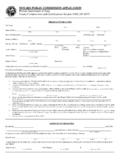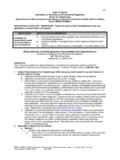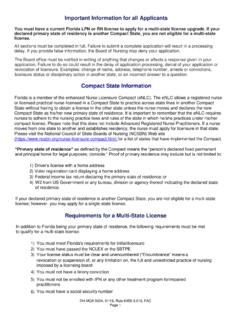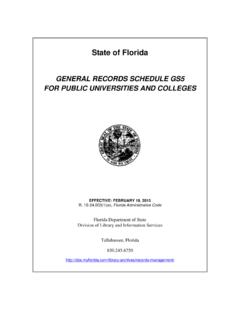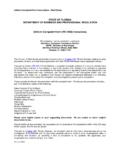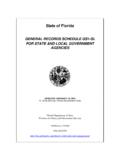Transcription of State Opioid Prescribing Policy: Florida - …
1 State Opioid Prescribing policy : Florida Pain policy and Regulation: Florida General Policies of the Florida Boards of Medicine and Osteopathic Medicine (Boards). The Boards recognize that "controlled substances, including Opioid analgesics, may be essential in the treatment of acute pain due to trauma or surgery and chronic pain, whether due to cancer or non-cancer origins.". The Boards consider " Prescribing , ordering, administering, or dispensing controlled substances for pain to be for a legitimate medical purpose if based on accepted scientific knowledge of the treatment of pain or if based on sound clinical grounds. All such Prescribing must be based on clear documentation of unrelieved pain and in compliance with applicable State or federal laws.
2 ". The Boards will not take disciplinary action against a physician for failing to adhere strictly to the provisions of their standards for the use of controlled substances in the treatment of pain "if good cause is shown for such deviations.". The Boards "will judge the validity of Prescribing based on the physician's treatment of the patient and on available documentation, rather than on the quantity and chronicity of Prescribing .". Definitions According to the Boards Pain: An unpleasant sensory and emotional experience associated with actual or potential tissue damage or described in terms of such damage. Acute pain: The normal, predicted physiologic response to an adverse chemical, thermal, or mechanical stimulus associated with surgery, trauma, and acute illness.
3 It is generally time-limited and is responsive to Opioid therapy among other therapies. Chronic pain: A pain State which is persistent. Physical dependence: A physiologic State of neuroadaptation that is characterized by the emergence of a withdrawal syndrome if drug use is stopped or decreased abruptly or if an antagonist is administered. Physical dependence is an expected result of Opioid use. Physical dependence by itself does not equate with addiction. Tolerance: A physiologic State resulting from regular use of a drug in which an increased dosage is needed to produce the same effect, or a reduced effect is observed with a constant dose. Addiction: A neurobehavioral syndrome with genetic and environmental influences that results in psychological dependence on the use of substances for their psychic effects and is characterized by compulsive use despite harm.
4 Physical dependence and tolerance are normal physiologic consequences of extended Opioid therapy for pain and should not be considered addiction. Pseudoaddiction: A pattern of drug-seeking behavior of patients with pain who are receiving inadequate pain management that can be mistaken for addiction. Standards for the Use of Controlled Substances for Pain According to the Boards Evaluation of the patient o Complete history and physical examination o Documented nature and intensity of pain o Underlying diseases and conditions o Effect of pain on physical and psychological functioning o History of substance abuse o Indication for use of controlled substances Treatment plan o Objectives used to determine treatment success o Further diagnostic evaluations or treatments planned o Therapy adjusted to individual patient needs Informed consent and agreement to treatment o Risks and benefits discussed with patient o When possible.
5 Patient should receive medications from one physician and one pharmacy o Written agreement if patient is determined to be at high risk: Urine/serum drug level tests Number and frequency of refills Reasons drug therapy may be discontinued (violation of agreement). o Periodic Review o At reasonable intervals o Reevaluate need for opioids if goals are not met o Monitor compliance Consultation o Refer as necessary o Extra care with patients having history of misuse or living arrangements conducive to misuse/diversion o Addiction medicine consult for patients with a history of abuse or comorbid psychiatric disorder Medical records o History and physical examination o Diagnostic, therapeutic, and laboratory results o Evaluations and consultations o Treatment objectives o Discussion of risks and benefits o Treatments o Medications (including date, type, dosage, and quantity prescribed).
6 O Instructions and agreements o Periodic reviews Compliance with controlled substance laws and regulations Standards for Dispensing of Controlled Substances for Pain by the Florida Board of Pharmacy Criteria that should cause a pharmacist to question legitimacy of a prescription: o Frequent loss of controlled substance prescriptions o Only controlled substance medications are prescribed for patient o One person presents controlled substance prescriptions with different patient names o Same or similar controlled substance medication prescribed by 2. or more prescribers at same time o Patient always pays cash and always insists on brand name product Action to take when legitimacy of a prescription is questioned: o Require photo identification of person requesting medication and photocopy the identification o Verify the prescription with the prescriber Every pharmacy must maintain record of controlled substances dispensed o Hard copy record must be provided covering previous 60 days o Must be made available within 72 hours of law enforcement request o Must include volume and identity of controlled substance dispensed by specific prescriber to specific patient A pharmacist with reason to believe that a prescriber is involved with diversion must report the prescriber to the Florida Department of Health Federal Controlled Substance Rules That Are Enforceable in Florida General rules o All controlled substance prescriptions must be issued
7 For a "legitimate medical purpose" and in the "usual course of professional practice". This is primarily the practitioner's responsibility Pharmacists have a corresponding responsibility to assure that this requirement has been met o Transfers of controlled substances by a pharmacy to a physician or clinic for office use must be done in the same way that controlled substances are acquired from a wholesaler or manufacturer. For C-II drugs, use either a paper form 222 or an electronic form 222. For C-III, C-IV, and C-V drugs, use an invoice retained on file Prescriptions issued without a specific patient name "for office use" cannot be filled o Under federal law, C-III and C-IV prescriptions may be authorized for refilling up to 5 times in 6 months following issuance.
8 Florida law imposes this requirement for C-V prescriptions also. o All controlled substance prescriptions must be dated on the date of issuance. o There is no maximum dose, maximum quantity, or maximum duration of therapy with controlled substance medications under federal law or Florida law. Specific rules for C-II prescriptions o Under federal law there is no time limit within which a C-II. prescription must be filled. In Florida , every prescription must be filled within 1 year of issuance, so that basic rule covers C-II prescriptions. o C-II prescriptions may not be refilled. Period. End of story. Never use the word "refill" with reference to the issuance of a continuing supply of C-II medication pursuant to a new prescription.
9 O Multiple C-II prescriptions may be issued on the same day for up to a 90-day continuing supply to be acquired periodically through new prescriptions that contain "do not fill until [mo-day-year]" instructions for the pharmacist. o Under certain circumstances, federal law permits a faxed prescription to serve as the original, and Florida law specifically defers to federal law on this matter. This applies under 3 circumstances: The prescription is for infusion treatment (narcotic C-II prescriptions only). The prescription is for a resident of a long-term care facility (LTCF) (any C-II prescription). The prescription is for a patient enrolled in hospice care (narcotic C-II prescriptions only). o A pharmacist may partially fill a C-II prescription if the pharmacist is unable to fill the prescription for the full amount The balance must be dispensed within 72 hours or not at all If the balance is not dispensed within 72 hours, the prescriber must be notified o A pharmacist may partially fill a C-II prescription over a period of 60 days, in periodic amounts up to the total amount prescribed, if the patient is either terminally ill or a long-term care patient.
10 The pharmacist must write either "terminally ill". or "LTCF patient" on the prescription For each partial filling, the date the prescription was partially filled, the quantity dispensed, the remaining quantify, and the identification of the dispensing pharmacist must be documented o In an emergency situation, a prescriber may verbally authorize a pharmacist to dispense a supply of C-II medication. Several rules apply to this process: The amount of medication dispensed is limited to that necessary to treat the patient during the emergency period The verbal order must be immediately reduced to writing by the pharmacist If the prescriber is not known to the pharmacist, the pharmacist must make a reasonable effort to verify the validity of the prescription, such as by calling the prescriber at a number listed in the telephone book Within 7 days following verbal authorization to dispense an emergency supply of C-II medication, the prescriber must furnish to the pharmacist a hard prescription that reflects the emergency order o No special Drug Enforcement Agency (DEA)
